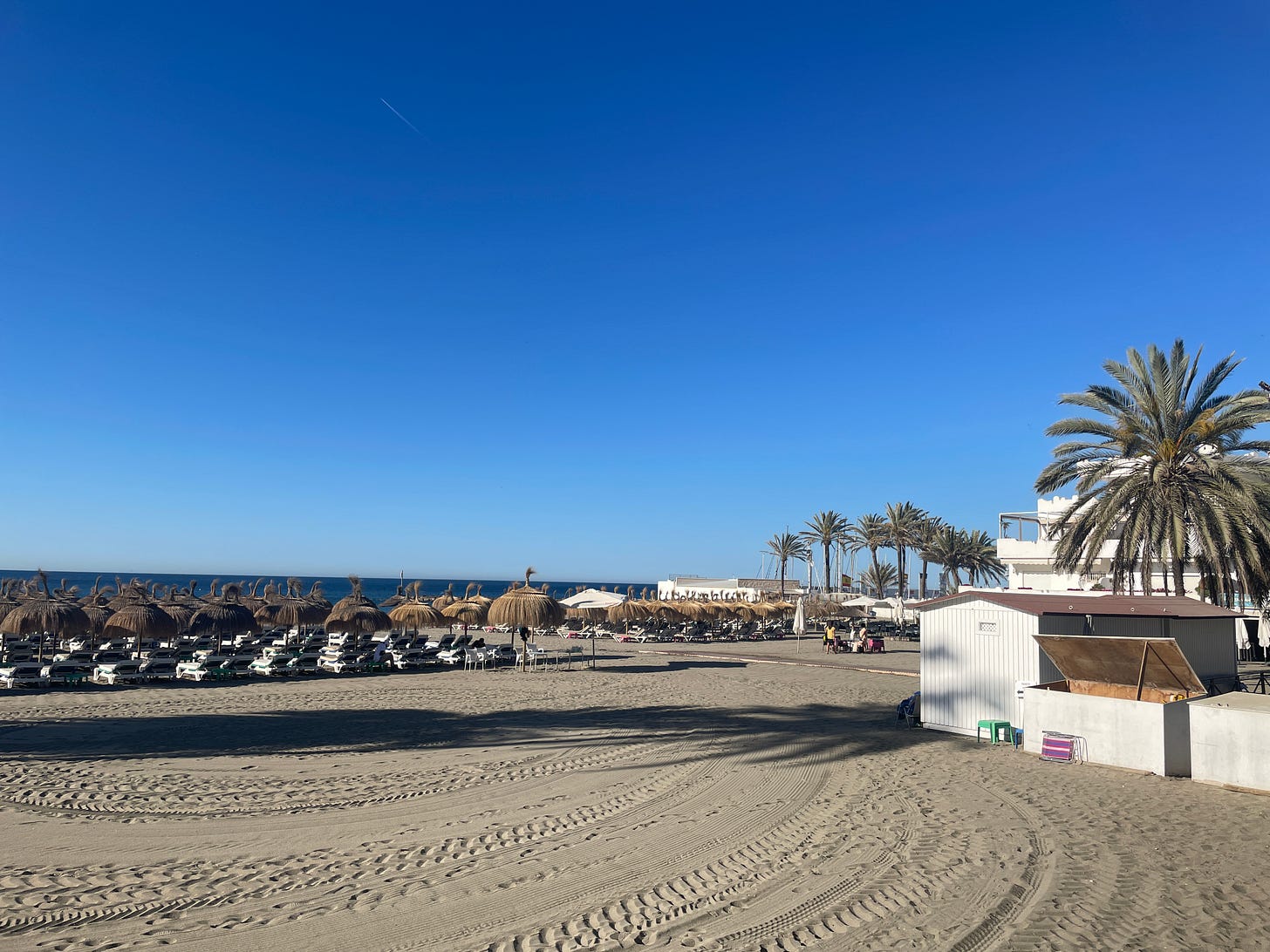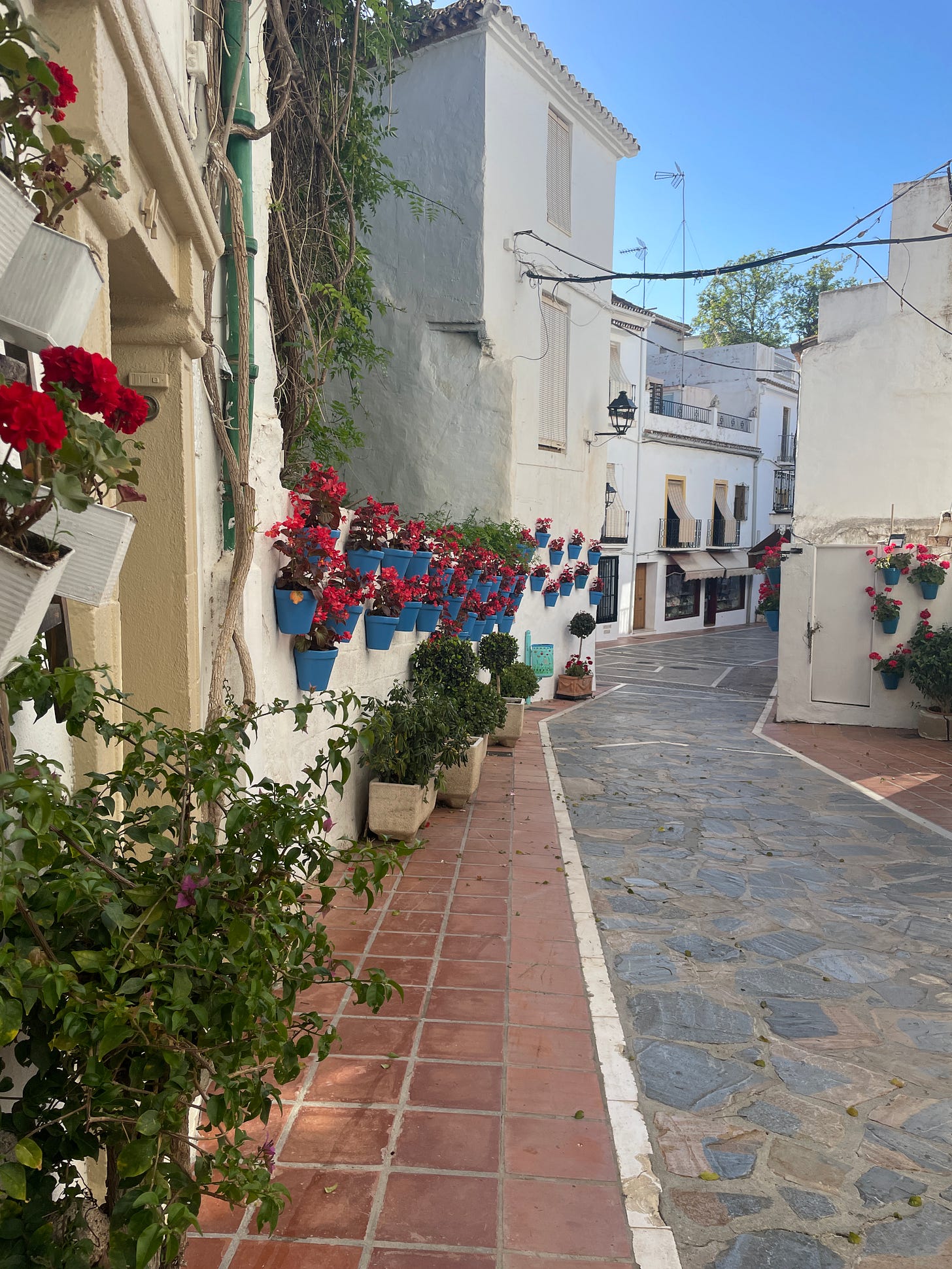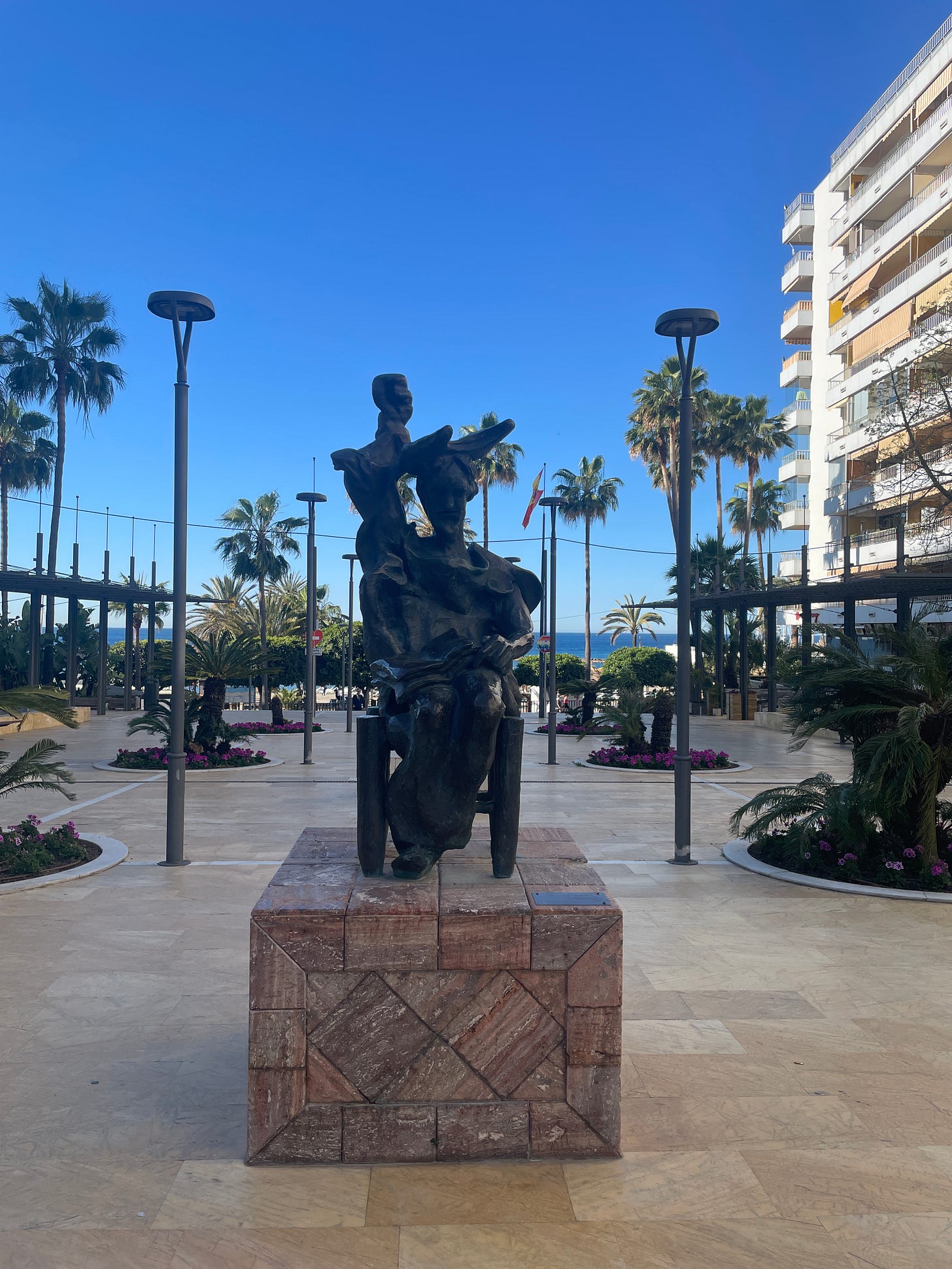An Adult Summer Camp, A Classic Thirst Trap: Marbella
Parque Sierra de Grazalema and the power of water, part 1
Hi! I’m picking up the keyboard again for a few Visible Cities posts. I’ll publish one every other week for at least 6 posts, mixing 3 on Parque Sierra de Grazalema in the south of Spain and 3 on Bolivia. Thanks for reading!
My visit to the wettest part of Spain starts in its thirstiest town.
Marbella’s old town tilts towards the Mediterranean. Its narrow streets are lined with white houses typical of Andalucia, of the area’s Arabic past. I will see other more characteristic pueblos blancos this week, but none more manicured. Flower pots of red poppies and pink roses adorn the walls. The center square, the plaza de los naranjos, holds an English hedge garden. Arabic tile and mosaic designs frame doorways, olive trees standing as guards. It is a city designed for the ‘gram. Its voice sounds like money.
That’s what I hear, at least. Marbella is the best-known resort town on the Costa del Sol, Spain’s biggest mainland beach destination – nudging out the Costa Blanca close to my current home, Valencia. Marbella boasts a long, pristine beach that lacks no amenity except, in most of the tourist season I’m sure, space. Its old town shops triangulate between tourist kitsch, cultivated bohemian, and gaudy rich. Its golf courses dot the coast like grassy beads on a necklace. There are mountains in the distance. And the rich and famous trendsetters have been here for a long time.
Marbella first came to global attention when Sean Connery bought a house there as a place to get away, about 50 years ago. The always sunny town then became a destination for the wealthy, as well as a known den of corruption. Sun and then money are what make Marbella move.
This filters into the broader Marbellan society. I’m in town for an event, which is held at a college for the tourism industry. This is a few miles out of town, and when I get off the bus, Google directs me through a construction project and my shoes are all dusty by the time I arrive.
Thanks for reading Visible Cities! Subscribe for free to receive new posts in your email.
The people at the event are glamorous: the women tall and long legged and textbook pretty, the men wearing blazers and boat shoes, the European male outfit of casual elegance. When we go out for dinner, I chat with the president of the local club hosting our event. He’s Iranian but moved to Marbella as a high schooler – a local and someone with a different perspective at the same time. He tells stories about the big names – a friend who stumbled into Connery’s birthday party at a local restaurant by accident and then was invited to stay; another who moved into a house once owned by the notorious arms dealer Adnan Khashoggi, and who upon his move found documents left behind from various Khashoggi deals. “There’s a rung two below the Connery level,” my host says, “and I’ll sometimes see people there.
The makeup of these people is international. “Spanish cities I know seem to be 80% Spanish / 20% foreigners”, I say to the president, and he finishes my thought: “Here, it’s the reverse.” Which leads to funny juxtapositions. There’s the American who is thrilled to meet me, another American. She had done retreats in Marbella before the pandemic, then fled New York at the earliest opportunity during. “I was climbing the mountain La Concha (the mountain overlooking Marbella), and I thought, what do I have to go back to? Why not stay here?” She is dressed in a long, flowy dress that she calls bohemian, and she is trying to find a way to reposition her real estate expertise here. Her Spanish is still not developed and she can’t help but get into a respectfully heated conversation with a Palestinian from Sweden about the Israeli-Palestinian conflict (this in April, well before recent events), which only eases when they fall back into small talk about their ‘guiri’ – Northern European or American foreigner in Spain - status.
The “from Sweden” part is not a surprise. Norwegian Air’s CEO said that their most popular airport is Malaga, the big city thirty minutes east from here, ahead of Madrid, Barcelona, or Alicante. One also cannot be in a Spanish coastal area without bumping into Brits. The group I go out with runs the gamut of the types of people who live in a place like Marbella: an Englishwoman who recently left Gibraltar, an American working at Google, the Iranian local aforementioned, a young Russian woman dating a German-Spaniard, another Englishwoman recently moved to Malaga, and three Spaniards. Walking around the next morning, I hear Brazilian Portuguese, German, Russian from all sides, and a lot of accented but perfect English.
There is a working class, both foreign and local. Africans on the bus out to my event and walking around the modern parts of the town. “There are both types of Moroccans here,” my Iranian host tells me. “Those here to work and those here with money. The ones who work are higher up on the ladder than the local working Spaniards; they work harder.” I’m only here for 24 hours and with no way to evaluate this, but it is a reminder that there is a world underneath this bubble.
The morning I leave Marbella, I take a walk down to the beach and then around the old town. I see Dali statues set up next to the Plaza de la Alameda, leading to the sea – are they replicas or authentic? Evidently it is disputed. I try to glimpse the Moorish alcazaba (fortress) in the old town as I walk around the center, but never can quite find where it is behind the walls. The tourists are out for brunch – I will join soon enough – and the flowerpots hang. It’s only mid-April and not Holy Week, so the vibe is pleasant and not overrun.
One of the last things I do before town is walk through that Plaza de la Alameda. I pick up a Malagan newspaper at the kiosk on the edge of the plaza to read at brunch. And then as I walk through, I see a beautiful fountain. It reminds me of the Plaza de España in Sevilla, tile work that is both classic and a little gaudy, pictures of famous battles and events on the tiles, as well as town crests and even poetry, all just on the edge of kitsch. It’s the Fuente del Virgen de Rocio, named after one of the famous Christian relics of Andalucia. It is lovely.
As I stop to take its photo – because how can I not? – I see a woman walking around to the other side. She is dressed in a dark tan sleeveless dress. It is warm enough, but also it is 10am on a Sunday, and it seems early to be so elegant. Her long black hair falls down her back, landing next to a shopping bag slung over her shoulder. She wears heels, and clomps on the historical tiles to a bench, where she leaves her shopping bag. Another woman, wearing gray sweatpants and a plain t-shirt, is with her. The woman in a dress walks back to the west side of the fountain, strides her legs in a pose, hand on her hip, and looks back to the friend’s camera. I have already taken my photo by this point; she is a pixelated image in the background.







